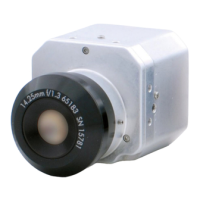38
Chapter
based on the temperature value of a
target area compared to a standard value
or compared to the target’s surroundings.
While this may not be accurate in an
absolute sense, it is the relative dierence
that is most important.
If the system developer wants accurate
temperature measurements on dierent
objects with dierent emissivities (e.g.,
for PC board inspections), then he/she
must create an emissivity map for the
camera’s FOV. This cannot be done with
the data coming out of a camera using
a global emissivity value. To create an
emissivity map, the developer will need
to write some program code, typically
by using the FLIR Software Developers
Kit. The routine that’s developed sets up
the system to read the FLIR proprietary
stream of data coming out of the A/D
converter and applies emissivity values
to it. This creates an emissivity map that
covers selected areas or spots within
the FOV.
Important Thermographic Principles
As alluded to above, there must be
a temperature dierence between a
target object and its surroundings in
order to create a useful thermographic
image. In most situations, the user also
needs a measurement of this relative
temperature dierence for decision
making, either automatically or by a
machine operator. However, there are a
few ambient conditions that may obscure
the temperature dierence.
In addition to emitting radiation, an
object reacts to incident radiation from
its surroundings by absorbing and
reecting a portion of it or by allowing
some of it to pass through (as through a
lens). Therefore, the maximum radiation
that impinges on an IR camera lens aimed
at an object comes from three sources:
(1) the object’s inherent temperature
without inuence from its surroundings,
(2) radiation from its surroundings that
was reected onto the object’s surface,
and (3) radiation that passed through the
object from behind. This is known as the
Total Radiation Law (see below). However,
all these radiation components become
attenuated as they pass through the
atmosphere on their way to the camera
lens. Since the atmosphere absorbs
part of the radiation, it also radiates
some itself.
Total Radiation Law
1 = α + ρ + τ.
The coecients α, ρ, and
τ describe an object’s
incident energy absorption
(α), reection (ρ), and
transmission (τ).
Figure 7. Total Radiation Law
The role of emissivity in distinguishing
an object’s temperature from its
surroundings was discussed above.
As alluded to earlier, it’s wise to take
precautions that prevent reected energy
from impinging on the target. Corrections
for atmospheric attenuation are normally
built into the camera rmware. Still,
other gases and hot steam between the
target and the camera lens can make
measurements impossible, or at least
inaccurate. Similarly, an object that is
transparent to IR wavelengths may result
in the camera measuring the background
behind it or some combination of the
object and the background.

